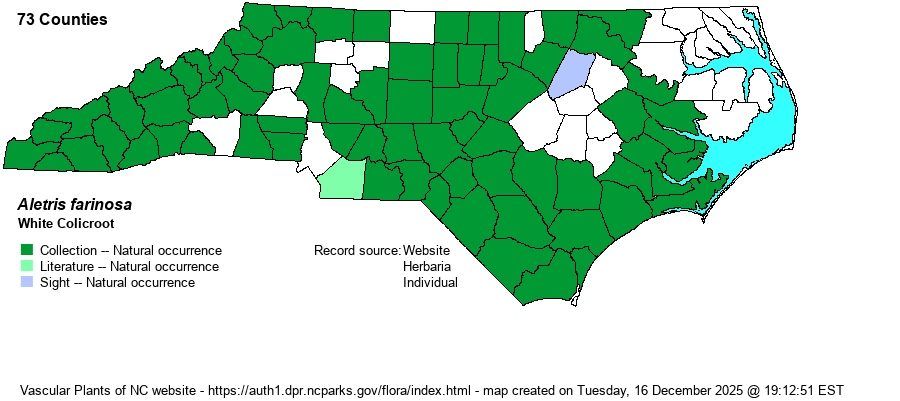| Author | L. | |
| Distribution | Occurs throughout the Mountains, Piedmont, and most of the Coastal Plain, but absent from the northeastern quarter of the last province (gaps north and south of Albemarle Sound). The odd "hole" in the map for the central Coastal Plain is likely an artifact of collecting effort or habitat loss.
Occurs over much of the eastern U.S., barely ranging into southern Ontario. It occurs from southern ME and WI south to northern FL and eastern TX. It is most widespread in the Carolinas and VA than elsewhere. | |
| Abundance | Fairly common to common (i.e., "frequent") statewide except in the northeastern Coastal Plain, where essentially absent. Not numerous in some parts of the western Coastal Plain, but on the whole is one of the more widely seen "lily" species in the state. | |
| Habitat | This species favors sun or mostly sunny places, in dry to mesic soil conditions, often in "grassy places". It can be found in powerline clearings, old fields, woodland borders, woodland openings, as well as in more moist places such as pine flatwoods and savannas, pocosin margins, and seepages. It can range to mafic glades and fens, as well as in acidic soils. Its main limitation is deep shade. | |
| Phenology | Blooms from late April to early June, though May is the chief month of blooming. Fruits in July and August. | |
| Identification | This widely seen species has a basal rosette of entire, narrowly elliptical leaves that reach about 4 inches long. The flowering scape is quite tall and often is close to 2 feet high, being quite like a wand. The upper 5-6 inches of the scape contains a fairly dense raceme of several dozen small white, very rough and mealy, tubular flowers. In reality, there should be no other species that could be confused with it, at least up close when the rough flowers are seen. Most biologists run into it on a number of occasions during the year, particularly when walking a powerline clearing, an old field, or a pine flatwoods or savanna. | |
| Taxonomic Comments | None
| |
| Other Common Name(s) | Mealy Colicroot, Unicorn-root, True Unicorn, White Stargrass (a very poor name used mostly for Hypoxis species) | |
| State Rank | S5 | |
| Global Rank | G5 | |
| State Status | | |
| US Status | | |
| USACE-agcp | FAC link |
| USACE-emp | FAC link |

